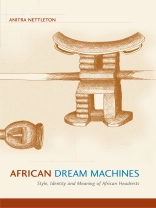African Dream Machines takes African headrests out of the category of functional objects and into the more rarefied category of ‘art’ objects. Styles in African headrests are usually defined in terms of western art and archaeological discourses, but this book interrogates these definitions of style and demonstrates the shortcomings of defining a single formal style model as exclusive to a single ethnic group.
Among the artefacts made by southern African peoples, headrests were the best known. Anitra Nettleton’s study of the uses and forms of headrests opened up a number of art-historical methodologies in the attempt to gain an understanding of form, style and content in African art objects. Her drawings of each and every headrest encountered become a major part of the project.
Table of Content
Preface
Acknowledgements
Notes on the Use of African Ethnic Names and Country and Place Names
References to illustrations in the Text and Notes on Illustrations
Chapter 1 Headrests and Art
Chapter 2 A Matter of Style, or Why Style Matters
Chapter 3 Methodology, Position and Limitations
Chapter 4 The Geographical and Chronological Distribution of the Contribution of the Columned Headrest
Chapter 5 Authenticity and History
Chapter 6 East African Headrests: Identity, Form and Aesthetics
Chapter 7 Tracing Histories: Central and Southern African Connections
Chapter 8 Not just a Curious Beauty: The Anatomy of Meaning in Useful Objects
Notes to Chapters
Bibliography
List of Illustrations
Index
About the author
Anitra Nettleton was the Chair and Director of the Centre for Creative Arts of Africa at the Wits Art Museum (University of the Witwatersrand, Johannesburg) until her retirment in 2016. Instrumental in founding the Standard Bank Collection of African Art at the Wits Art Museum in 1978, she has curated many exhibitions, and taught at Wits University for 35 years.












